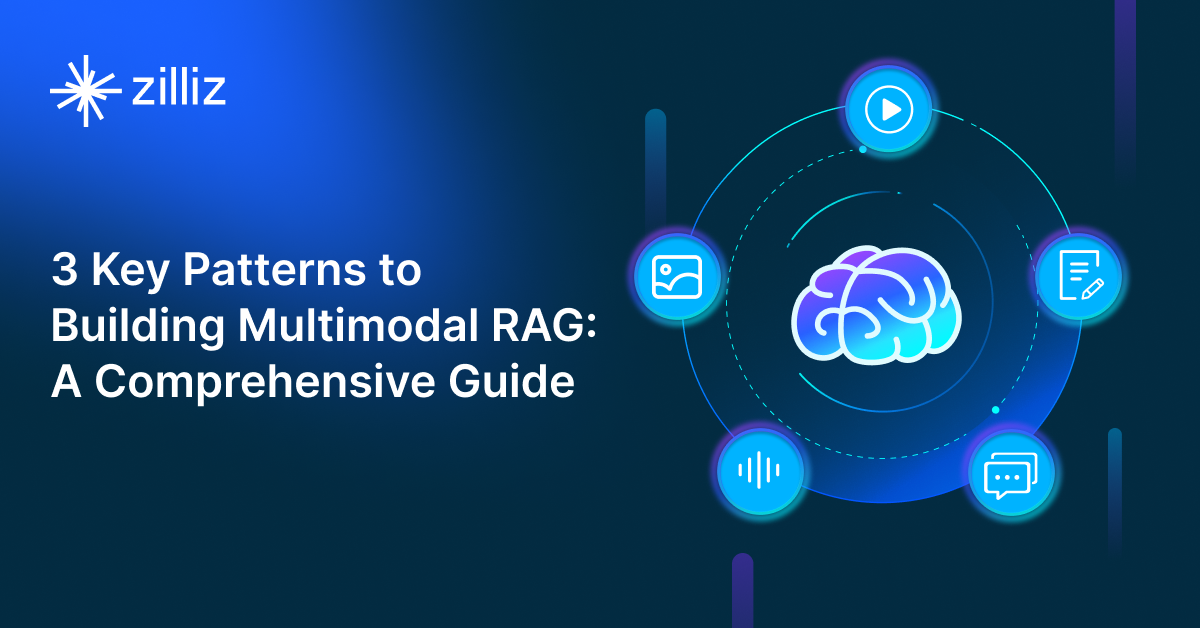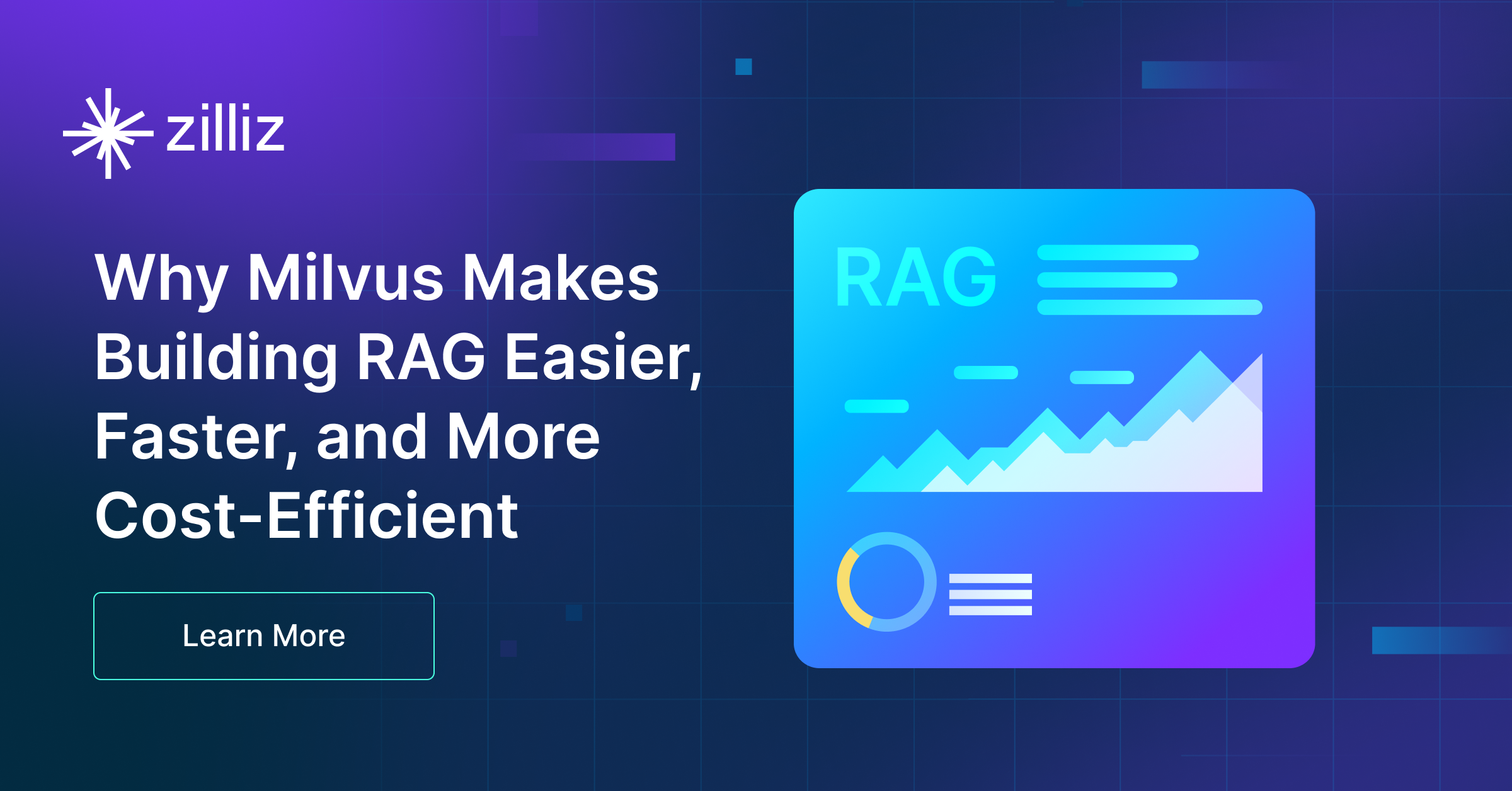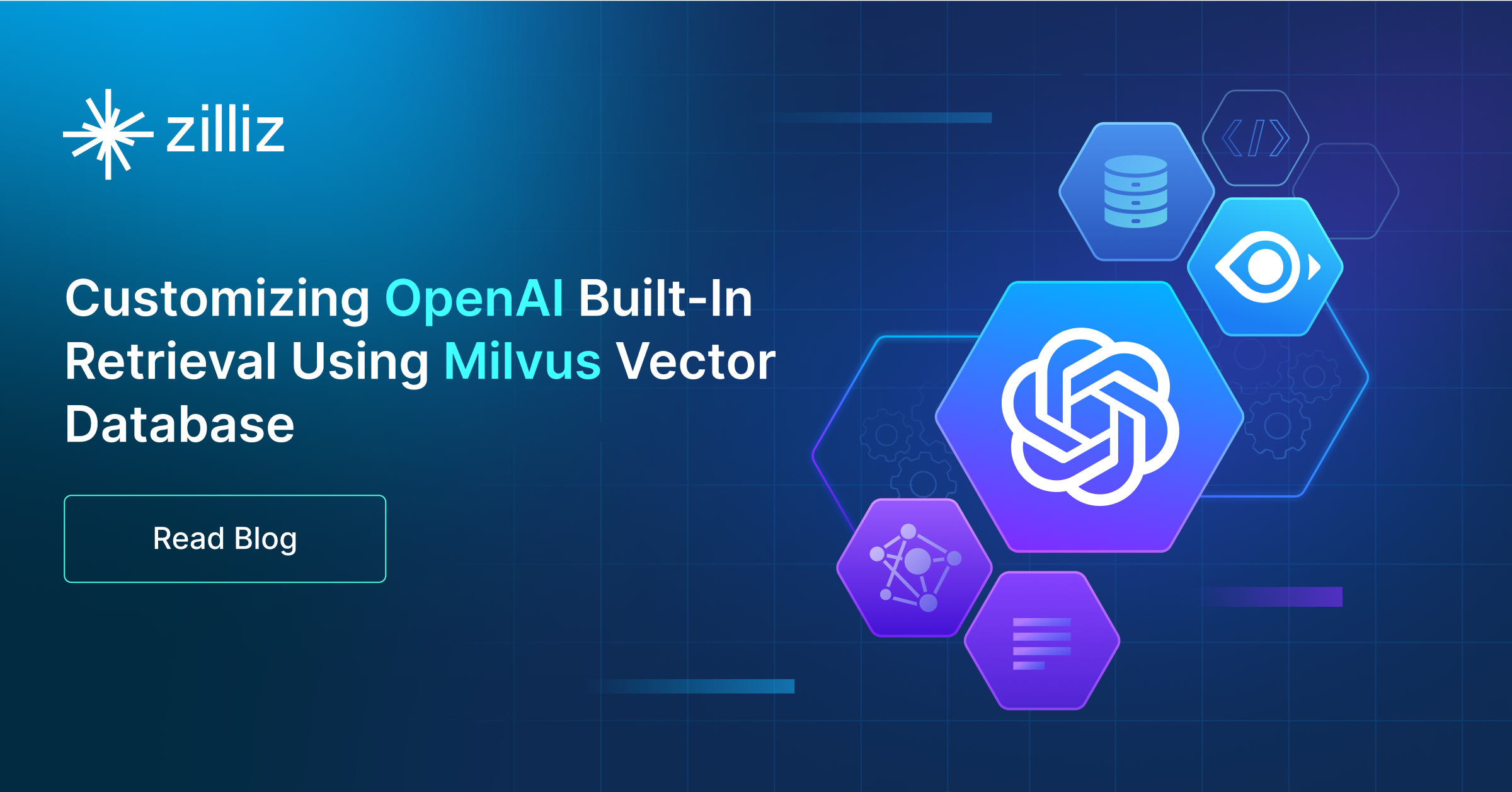Build RAG Chatbot with LangChain, Zilliz Cloud, Fireworks AI DeepSeek R1, and Ollama granite-embedding
Introduction to RAG
Retrieval-Augmented Generation (RAG) is a game-changer for GenAI applications, especially in conversational AI. It combines the power of pre-trained large language models (LLMs) like OpenAI’s GPT with external knowledge sources stored in vector databases such as Milvus and Zilliz Cloud, allowing for more accurate, contextually relevant, and up-to-date response generation. A RAG pipeline usually consists of four basic components: a vector database, an embedding model, an LLM, and a framework.
Key Components We'll Use for This RAG Chatbot
This tutorial shows you how to build a simple RAG chatbot in Python using the following components:
- LangChain: An open-source framework that helps you orchestrate the interaction between LLMs, vector stores, embedding models, etc, making it easier to integrate a RAG pipeline.
- Zilliz Cloud: a fully managed vector database-as-a-service platform built on top of the open-source Milvus, designed to handle high-performance vector data processing at scale. It enables organizations to efficiently store, search, and analyze large volumes of unstructured data, such as text, images, or audio, by leveraging advanced vector search technology. It offers a free tier supporting up to 1 million vectors.
- Fireworks AI DeepSeek R1: This advanced model specializes in deep data exploration and insight generation. With robust analytical capabilities and high accuracy, it efficiently identifies patterns and trends within large datasets. Ideal for business intelligence, market analysis, and research applications, DeepSeek R1 empowers organizations to make data-driven decisions confidently.
- Ollama Granite-Embedding: This AI model specializes in generating high-quality embeddings for various data types, enhancing search and recommendation systems. Its strength lies in its ability to capture complex relationships within data, making it ideal for applications like semantic search, natural language processing, or personalization in digital platforms.
By the end of this tutorial, you’ll have a functional chatbot capable of answering questions based on a custom knowledge base.
Note: Since we may use proprietary models in our tutorials, make sure you have the required API key beforehand.
Step 1: Install and Set Up LangChain
%pip install --quiet --upgrade langchain-text-splitters langchain-community langgraph
Step 2: Install and Set Up Fireworks AI DeepSeek R1
pip install -qU "langchain[fireworks]"
import getpass
import os
if not os.environ.get("FIREWORKS_API_KEY"):
os.environ["FIREWORKS_API_KEY"] = getpass.getpass("Enter API key for Fireworks AI: ")
from langchain.chat_models import init_chat_model
llm = init_chat_model("accounts/fireworks/models/deepseek-r1", model_provider="fireworks")
Step 3: Install and Set Up Ollama granite-embedding
pip install -qU langchain-ollama
from langchain_ollama import OllamaEmbeddings
embeddings = OllamaEmbeddings(model="granite-embedding")
Step 4: Install and Set Up Zilliz Cloud
pip install -qU langchain-milvus
from langchain_milvus import Zilliz
vector_store = Zilliz(
embedding_function=embeddings,
connection_args={
"uri": ZILLIZ_CLOUD_URI,
"token": ZILLIZ_CLOUD_TOKEN,
},
)
Step 5: Build a RAG Chatbot
Now that you’ve set up all components, let’s start to build a simple chatbot. We’ll use the Milvus introduction doc as a private knowledge base. You can replace it with your own dataset to customize your RAG chatbot.
import bs4
from langchain import hub
from langchain_community.document_loaders import WebBaseLoader
from langchain_core.documents import Document
from langchain_text_splitters import RecursiveCharacterTextSplitter
from langgraph.graph import START, StateGraph
from typing_extensions import List, TypedDict
# Load and chunk contents of the blog
loader = WebBaseLoader(
web_paths=("https://milvus.io/docs/overview.md",),
bs_kwargs=dict(
parse_only=bs4.SoupStrainer(
class_=("doc-style doc-post-content")
)
),
)
docs = loader.load()
text_splitter = RecursiveCharacterTextSplitter(chunk_size=1000, chunk_overlap=200)
all_splits = text_splitter.split_documents(docs)
# Index chunks
_ = vector_store.add_documents(documents=all_splits)
# Define prompt for question-answering
prompt = hub.pull("rlm/rag-prompt")
# Define state for application
class State(TypedDict):
question: str
context: List[Document]
answer: str
# Define application steps
def retrieve(state: State):
retrieved_docs = vector_store.similarity_search(state["question"])
return {"context": retrieved_docs}
def generate(state: State):
docs_content = "\n\n".join(doc.page_content for doc in state["context"])
messages = prompt.invoke({"question": state["question"], "context": docs_content})
response = llm.invoke(messages)
return {"answer": response.content}
# Compile application and test
graph_builder = StateGraph(State).add_sequence([retrieve, generate])
graph_builder.add_edge(START, "retrieve")
graph = graph_builder.compile()
Test the Chatbot
Yeah! You've built your own chatbot. Let's ask the chatbot a question.
response = graph.invoke({"question": "What data types does Milvus support?"})
print(response["answer"])
Example Output
Milvus supports various data types including sparse vectors, binary vectors, JSON, and arrays. Additionally, it handles common numerical and character types, making it versatile for different data modeling needs. This allows users to manage unstructured or multi-modal data efficiently.
Optimization Tips
As you build your RAG system, optimization is key to ensuring peak performance and efficiency. While setting up the components is an essential first step, fine-tuning each one will help you create a solution that works even better and scales seamlessly. In this section, we’ll share some practical tips for optimizing all these components, giving you the edge to build smarter, faster, and more responsive RAG applications.
LangChain optimization tips
To optimize LangChain, focus on minimizing redundant operations in your workflow by structuring your chains and agents efficiently. Use caching to avoid repeated computations, speeding up your system, and experiment with modular design to ensure that components like models or databases can be easily swapped out. This will provide both flexibility and efficiency, allowing you to quickly scale your system without unnecessary delays or complications.
Zilliz Cloud optimization tips
Optimizing Zilliz Cloud for a RAG system involves efficient index selection, query tuning, and resource management. Use Hierarchical Navigable Small World (HNSW) indexing for high-speed, approximate nearest neighbor search while balancing recall and efficiency. Fine-tune ef_construction and M parameters based on your dataset size and query workload to optimize search accuracy and latency. Enable dynamic scaling to handle fluctuating workloads efficiently, ensuring smooth performance under varying query loads. Implement data partitioning to improve retrieval speed by grouping related data, reducing unnecessary comparisons. Regularly update and optimize embeddings to keep results relevant, particularly when dealing with evolving datasets. Use hybrid search techniques, such as combining vector and keyword search, to improve response quality. Monitor system metrics in Zilliz Cloud’s dashboard and adjust configurations accordingly to maintain low-latency, high-throughput performance.
Fireworks AI DeepSeek R1 optimization tips
DeepSeek R1 is a strong model for RAG applications requiring high-quality retrieval and generation. Optimize performance by using an efficient document embedding strategy, ensuring that retrieved documents are highly relevant before passing them to the model. Structure prompts effectively, emphasizing key details upfront to guide responses. Set temperature between 0.1 and 0.2 for factual accuracy and adjust top-p for response variety when needed. Minimize latency by caching frequent queries and using batched API calls for bulk processing. If running on Fireworks AI infrastructure, take advantage of GPU acceleration to improve throughput. Implement response streaming for interactive applications requiring low-latency output. Continuously monitor query performance and adjust retrieval depth based on complexity to optimize efficiency.
Ollama granite-embedding optimization tips
To optimize the Ollama granite-embedding component in your Retrieval-Augmented Generation (RAG) setup, ensure that you preprocess your text data to remove noise and irrelevant information, enhancing the quality of embeddings. Leverage batch processing to create embeddings in bulk, which can significantly improve throughput and reduce computational overhead. Experiment with different embedding dimensions to find the optimal trade-off between accuracy and performance for your specific use case. Additionally, consider fine-tuning your embeddings model on domain-specific data to enhance reactivity and relevance in your retrieval tasks. Finally, regularly monitor and evaluate performance metrics to identify bottlenecks and iteratively refine your approach.
By implementing these tips across your components, you'll be able to enhance the performance and functionality of your RAG system, ensuring it’s optimized for both speed and accuracy. Keep testing, iterating, and refining your setup to stay ahead in the ever-evolving world of AI development.
RAG Cost Calculator: A Free Tool to Calculate Your Cost in Seconds
Estimating the cost of a Retrieval-Augmented Generation (RAG) pipeline involves analyzing expenses across vector storage, compute resources, and API usage. Key cost drivers include vector database queries, embedding generation, and LLM inference.
RAG Cost Calculator is a free tool that quickly estimates the cost of building a RAG pipeline, including chunking, embedding, vector storage/search, and LLM generation. It also helps you identify cost-saving opportunities and achieve up to 10x cost reduction on vector databases with the serverless option.
 Calculate your RAG cost
Calculate your RAG cost
What Have You Learned?
By diving into this tutorial, you’ve unlocked the magic of building a RAG system from the ground up! You now understand how LangChain acts as the glue that ties everything together, orchestrating workflows and simplifying complex interactions between components. Zilliz Cloud steps in as your powerhouse vector database, storing and retrieving embeddings at lightning speed, while Ollama’s granite-embedding model transforms raw text into rich, meaningful vectors that capture the essence of your data. And let’s not forget Fireworks AI’s DeepSeek R1—this LLM brings your system to life, generating human-like responses that feel natural and insightful. Together, these tools create a seamless pipeline where data flows from ingestion to intelligent output, empowering you to build applications that learn and adapt in real time. Plus, you picked up pro tips like optimizing chunking strategies and using metadata filtering to boost performance—skills that’ll save you time and resources down the line. Oh, and that free RAG cost calculator? It’s your secret weapon for balancing speed, accuracy, and budget as you scale!
But this is just the beginning. You’ve got the blueprint—now it’s time to build, experiment, and innovate! Whether you’re crafting chatbots that wow users, enhancing search engines with AI intuition, or tackling entirely new challenges, you’re equipped to turn ideas into reality. Remember, every tweak and optimization you make pushes the boundaries of what’s possible. So fire up your code editor, play with parameters, and let your creativity run wild. The future of intelligent applications is in your hands, and with tools like these, there’s no limit to what you can create. Go build something awesome—we can’t wait to see what you come up with next! 🚀
Further Resources
🌟 In addition to this RAG tutorial, unleash your full potential with these incredible resources to level up your RAG skills.
- How to Build a Multimodal RAG | Documentation
- How to Enhance the Performance of Your RAG Pipeline
- Graph RAG with Milvus | Documentation
- How to Evaluate RAG Applications - Zilliz Learn
- Generative AI Resource Hub | Zilliz
We'd Love to Hear What You Think!
We’d love to hear your thoughts! 🌟 Leave your questions or comments below or join our vibrant Milvus Discord community to share your experiences, ask questions, or connect with thousands of AI enthusiasts. Your journey matters to us!
If you like this tutorial, show your support by giving our Milvus GitHub repo a star ⭐—it means the world to us and inspires us to keep creating! 💖
- Introduction to RAG
- Key Components We'll Use for This RAG Chatbot
- Step 1: Install and Set Up LangChain
- Step 2: Install and Set Up Fireworks AI DeepSeek R1
- Step 3: Install and Set Up Ollama granite-embedding
- Step 4: Install and Set Up Zilliz Cloud
- Step 5: Build a RAG Chatbot
- Optimization Tips
- RAG Cost Calculator: A Free Tool to Calculate Your Cost in Seconds
- What Have You Learned?
- Further Resources
- We'd Love to Hear What You Think!
Content
Vector Database at Scale
Zilliz Cloud is a fully-managed vector database built for scale, perfect for your RAG apps.
Try Zilliz Cloud for Free


